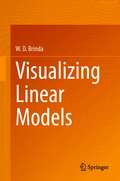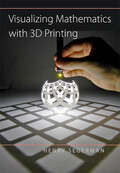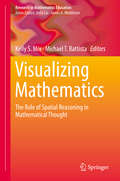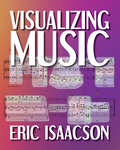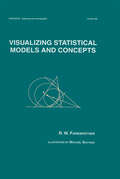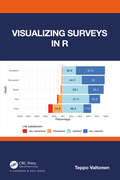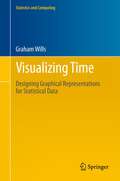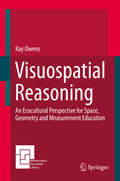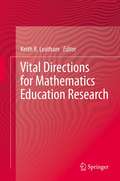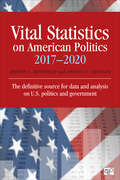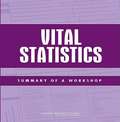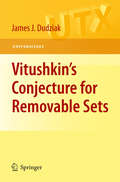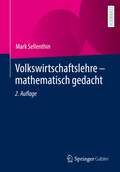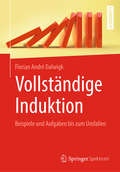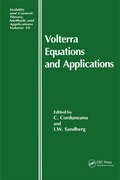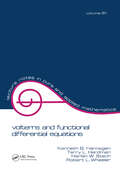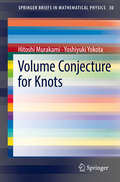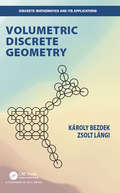- Table View
- List View
Visualizing Linear Models
by W. D. BrindaThis book provides a visual and intuitive coverage of the core theory of linear models. Designed to develop fluency with the underlying mathematics and to build a deep understanding of the principles, it's an excellent basis for a one-semester course on statistical theory and linear modeling for intermediate undergraduates or graduate students. Three chapters gradually develop the essentials of linear model theory. They are each preceded by a review chapter that covers a foundational prerequisite topic. This classroom-tested work explores two distinct and complementary types of visualization: the “observations picture” and the “variables picture.” To improve retention of material, this book is supplemented by a bank of ready-made practice exercises for students. These are available for digital or print use.
Visualizing Mathematics with 3D Printing
by Henry SegermanThe first book to explain mathematics using 3D printed models.Winner of the Technical Text of the Washington PublishersWouldn’t it be great to experience three-dimensional ideas in three dimensions? In this book—the first of its kind—mathematician and mathematical artist Henry Segerman takes readers on a fascinating tour of two-, three-, and four-dimensional mathematics, exploring Euclidean and non-Euclidean geometries, symmetry, knots, tilings, and soap films. Visualizing Mathematics with 3D Printing includes more than 100 color photographs of 3D printed models. Readers can take the book’s insights to a new level by visiting its sister website, 3dprintmath.com, which features virtual three-dimensional versions of the models for readers to explore. These models can also be ordered online or downloaded to print on a 3D printer. Combining the strengths of book and website, this volume pulls higher geometry and topology out of the realm of the abstract and puts it into the hands of anyone fascinated by mathematical relationships of shape. With the book in one hand and a 3D printed model in the other, readers can find deeper meaning while holding a hyperbolic honeycomb, touching the twists of a torus knot, or caressing the curves of a Klein quartic.
Visualizing Mathematics: The Role of Spatial Reasoning in Mathematical Thought (Research in Mathematics Education)
by Michael T. Battista Kelly S. MixThis unique volume surveys recent research on spatial visualization in mathematics in the fields of cognitive psychology and mathematics education. The general topic of spatial skill and mathematics has a long research tradition, but has been gaining attention in recent years, although much of this research happens in disconnected subfields. This volume aims to promote interaction between researchers, not only to provide a more comprehensive view of spatial visualization and mathematics, but also to stimulate innovative new directions in research based on a more coordinated effort. It features ten chapters authored by leading researchers in cognitive psychology and mathematics education, as well as includes dynamic commentaries by mathematics education researchers on cognitive psychology chapters, and by cognitive psychologists on mathematics education chapters. Among the topics included: From intuitive spatial measurement to understanding of units. Spatial reasoning: a critical problem-solving tool in children’s mathematics strategy tool-kit. What processes underlie the relation between spatial skill and mathematics? Learning with and from drawing in early years geometry. Communication of visual information and complexity of reasoning by mathematically talented students. Visualizing Mathematics makes substantial progress in understanding the role of spatial reasoning in mathematical thought and in connecting various subfields of research. It promises to make an impact among psychologists, education scholars, and mathematics educators in the convergence of psychology and education.
Visualizing Music
by Eric IsaacsonTo feel the emotional force of music, we experience it aurally. But how can we convey musical understanding visually?Visualizing Music explores the art of communicating about music through images. Drawing on principles from the fields of vision science and information visualization, Eric Isaacson describes how graphical images can help us understand music. By explaining the history of music visualizations through the lens of human perception and cognition, Isaacson offers a guide to understanding what makes musical images effective or ineffective and provides readers with extensive principles and strategies to create excellent images of their own. Illustrated with over 300 diagrams from both historical and modern sources, including examples and theories from Western art music, world music, and jazz, folk, and popular music, Visualizing Music explores the decisions made around image creation. Together with an extensive online supplement and dozens of redrawings that show the impact of effective techniques, Visualizing Music is a captivating guide to thinking differently about design that will help music scholars better understand the power of musical images, thereby shifting the ephemeral to material.
Visualizing Statistical Models And Concepts
by R.W. Farebrother Michael SchynsExamines classic algorithms, geometric diagrams, and mechanical principles for enhancing visualization of statistical estimation procedures and mathematical concepts in physics, engineering, and computer programming.
Visualizing Surveys in R
by Teppo ValtonenVisualizing Surveys in R is about creating static, print quality figures from survey data using R. The focus is not, for example, on statistical analysis of survey data, but rather on giving concrete solutions for typical problems in visualizing survey data. While there are many excellent books on data visualization, surveys and R, the aim of this book is to bring these topics together, and offer practical instructions for visualizing surveys in R. Features • Introduction to survey data: variables, categories, and scales • Description of a process for visualizing survey data • Recommendations for reading survey data into R • Advice on building a survey dataset in R to facilitate versatile plotting • Step-by-step recipes in R for creating useful plots from survey data The book is intended for researchers who regularly use surveys and are interested in learning how to seize the vast possibilities and the flexibility of R in survey analysis and visualizations. The book is also valuable for psychologists, marketeers, HR personnel, managers, and other professionals who wish to standardize and automate the process for visualizing survey data. Finally, the book is suitable as a course textbook, either more widely on survey studies, or more strictly on visualizing survey data in R.
Visualizing Time
by Graham WillsArt, or Science? Which of these is the right way to think of the field of visualization? This is not an easy question to answer, even for those who have many years experience in making graphical depictions of data with a view to help people understand it and take action. In this book, Graham Wills bridges the gap between the art and the science of visually representing data. He does not simply give rules and advice, but bases these on general principles and provide a clear path between them This book is concerned with the graphical representation of time data and is written to cover a range of different users. A visualization expert designing tools for displaying time will find it valuable, but so also should a financier assembling a report in a spreadsheet, or a medical researcher trying to display gene sequences using a commercial statistical package.
Visuospatial Reasoning
by Kay OwensThis book develops the theoretical perspective on visuospatial reasoning in ecocultural contexts, granting insights on how the language, gestures, and representations of different cultures reflect visuospatial reasoning in context. For a number of years, two themes in the field of mathematics education have run parallel with each other with only a passing acquaintance. These two areas are the psychological perspective on visuospatial reasoning and ecocultural perspectives on mathematics education. This volume examines both areas of research and explores the intersection of these powerful ideas. In addition, there has been a growing interest in sociocultural aspects of education and in particular that of Indigenous education in the field of mathematics education. There has not, however, been a sound analysis of how environmental and cultural contexts impact visuospatial reasoning, although it was noted as far back as the 1980s when Alan Bishop developed his duality of visual processing and interpreting visual information. This book provides this analysis and in so doing not only articulates new and worthwhile lines of research, but also uncovers and makes real a variety of useful professional approaches in teaching school mathematics. With a renewed interest in visuospatial reasoning in the mathematics education community, this volume is extremely timely and adds significantly to current literature on the topic.
Vital Directions for Mathematics Education Research
by Keith R LeathamThis book provides a collection of chapters from prominent mathematics educators in which they each discuss vital issues in mathematics education and what they see as viable directions research in mathematics education could take to address these issues. All of these issues are related to learning and teaching mathematics. The book consists of nine chapters, seven from each of seven scholars who participated in an invited lecture series (Scholars in Mathematics Education) at Brigham Young University, and two chapters from two other scholars who are writing reaction papers that look across the first seven chapters. The recommendations take the form of broad, overarching principles and ideas that cut across the field. In this sense, this book differs from classical "research agenda projects," which seek to outline specific research questions that the field should address around a central topic.
Vital Statistics on American Politics
by Jeffrey L. Bernstein Amanda C. ShannonThere is no other source that provides in one place the wide range and depth of insight found in Vital Statistics on American Politics (VSAP), published since 1988. VSAP provides historical and statistical information on all aspects of American politics: Political parties Voter turnout Public opinion Campaign finance Media perspective and influence, congressional membership and voting patterns The presidency and executive branch Military policy and spending Supreme Court and federal court make-up and caseloads Foreign, social, and economic policy In over 230 tables and figures, students and professional researchers will find chapters devoted to key subject areas such as elections and political parties, public opinion and voting, the media, the three branches of U.S. government, foreign, military, social and economic policy, and much more. This book provides a vivid and multifaceted portrait of the broad spectrum of United States politics and policies. Along with updated and new data content, this edition offers brand new data literacy lessons that take a "guide on the side" approach to teach data researchers how to wade through the sea of data and do the difficult work of grappling for the meaning of the data on their own. Lessons include understanding descriptive representation data, comparing data over time, noticing gaps in data, unpacking dichotomies of public opinion, and more.
Vital Statistics on American Politics
by Jeffrey L. Bernstein Amanda C. ShannonThere is no other source that provides in one place the wide range and depth of insight found in Vital Statistics on American Politics (VSAP), published since 1988. VSAP provides historical and statistical information on all aspects of American politics: Political parties Voter turnout Public opinion Campaign finance Media perspective and influence, congressional membership and voting patterns The presidency and executive branch Military policy and spending Supreme Court and federal court make-up and caseloads Foreign, social, and economic policy In over 230 tables and figures, students and professional researchers will find chapters devoted to key subject areas such as elections and political parties, public opinion and voting, the media, the three branches of U.S. government, foreign, military, social and economic policy, and much more. This book provides a vivid and multifaceted portrait of the broad spectrum of United States politics and policies. Along with updated and new data content, this edition offers brand new data literacy lessons that take a "guide on the side" approach to teach data researchers how to wade through the sea of data and do the difficult work of grappling for the meaning of the data on their own. Lessons include understanding descriptive representation data, comparing data over time, noticing gaps in data, unpacking dichotomies of public opinion, and more.
Vital Statistics: Summary of a Workshop
by National Research Council of the National AcademiesVital statistics, the records of birth and death, are a critical national information resource for understanding public health. Over the past few decades, the specific program that gathers the data has evolved into a complex cooperative program between the federal and state governments for social measurement. The Vital Statistics Cooperative Program (VSCP) is currently maintained by the National Center for Health Statistics (NCHS). The U.S. vital statistics system relies on the original information reported by myriad individuals, channeled through varying state and local information systems, and coordinated and processed by a federal statistical agency that has experienced relatively flat funding for many years. The challenges facing the vital statistics system and the continuing importance of the resulting data make it an important topic for examination. A workshop, held by the National Academies and summarized in this volume, considered the importance of adequate vital statistics. In particular, the workshop assessed both current and emerging uses of the data, considered the methodological and organizational features of compiling vital data, and identified possible visions for the vital statistics program.
Vitiation of Contracts
by Gareth SparkVitiation of Contracts proposes a new theory to explain the rationale of general vitiating factors in English contract law. It provides a clear link to voluntariness as the foundation of contractual liability and compares the English position, in light of this theory, with the Principles of International Commercial Contracts (PICC), the Principles of European Contract Law (PECL), the Draft Common Frame of Reference (DCFR) and the US Restatement (Second) of Contracts.
Vito Volterra
by Giovanni Paoloni Angelo Guerraggio Kim WilliamsVito Volterra (1860-1940) was one of the most famous representatives of Italian science in his day. Angelo Guerragio and Giovanni Paolini analyze Volterra's most important contributions to mathematics and their applications, as well as his outstanding organizational achievements in scientific policy. Volterra was one of the founding fathers of functional analysis and the author of fundamental contributions in the field of integral equations, elasticity theory and population dynamics (Lotka-Volterra model). He delivered keynote lectures on the occasion of the International Congresses of Mathematicians held in Paris (1900), Rome (1908), Strasbourg (1920) and Bologna (1928). He became involved in the scientific development in united Italy and was appointed senator of the kingdom in 1905. One of his numerous non-mathematical activities was founding the National Research Council (Consiglio Nazionale delle Ricerche, CNR). During the First World War he was active in military research. After the war he took a clear stand against fascism, which was the starting point for his exclusion. In 1926 he resigned as president of the world famous Accademia Nazionale dei Lincei and was later on excluded from the academy. In 1931 he was one of the few university lecturers who denied to swear an oath of allegiance to the fascistic regime. In 1938 he suffered from the impact of the racial laws. The authors draw a comprehensive picture of Vito Volterra, both as a great mathematician and an organizer of science.
Vitushkin’s Conjecture for Removable Sets
by James DudziakVitushkin's conjecture, a special case of Painlevé's problem, states that a compact subset of the complex plane with finite linear Hausdorff measure is removable for bounded analytic functions if and only if it intersects every rectifiable curve in a set of zero arclength measure. Chapters 1-5 of the book provide important background material on removability, analytic capacity, Hausdorff measure, arclength measure, and Garabedian duality that will appeal to many analysts with interests independent of Vitushkin's conjecture. The fourth chapter contains a proof of Denjoy's conjecture that employs Melnikov curvature. A brief postscript reports on a deep theorem of Tolsa and its relevance to going beyond Vitushkin's conjecture. This text can be used for a topics course or seminar in complex analysis. To understand it, the reader should have a firm grasp of basic real and complex analysis.
Volkswirtschaftslehre – mathematisch gedacht
by Mark SellenthinDieses Lehrbuch stellt die theoretischen Modelle der Volkswirtschaftslehre durch grundlegende mathematische Konzepte dar. Während eine wirtschaftswissenschaftliche akademische Karriere ohne fundierte Methodenkenntnisse undenkbar erscheint, sind in der akademischen Lehre die theoretischen Inhalte und die quantitativen Methoden zumeist relativ streng voneinander getrennt. Dieses Lehrbuch geht einen anderen Weg. Die Mathematik wird als lebendiger, integraler Bestandteil des wirtschaftswissenschaftlichen Studiums verstanden, ohne den weder ein tieferes theoretisches Verständnis noch eine empirische Anwendung möglich ist. Der Autor analysiert wesentliche Modelle aus der Mikro- und der Makroökonomik mit Hilfe mathematischer Ansätze. Der Anwendungsnutzen mathematischer Methoden steht dabei im Vordergrund und soll daher anhand von Musteraufgaben illustriert werden. Das vorliegende Lehrbuch richtet sich an Bachelorstudierende, die eine Einführung in die mathematische Modellierung grundlegender Modelle der Mikro- und Makroökonomik wünschen.Für die 2. Auflage wurde ein neues Kapitel zu den mathematischen Grundlagen ergänzt, das gebündelt alle benötigten Methoden für ein wirtschaftswissenschaftliches Studium vorstellt. Im Kapitel zur Makroökonomik wurde zudem die Makroökonomik offener Volkswirtschaften neu aufgenommen.
Vollständige Induktion: Beispiele und Aufgaben bis zum Umfallen
by Florian André DalwigkDein Professor spricht vom Beweisen mit vollständiger Induktion, aber du verstehst nur Bahnhof? Du willst endlich wissen, was es damit auf sich hat – und vor allem, wie du das in der Klausur hinkriegen sollst? In diesem Buch erfährst du es! Dabei ist es ganz egal, ob die Prüfung schon kurz bevor steht und du eine Rettung in letzter Sekunde suchst, oder ob du etwas mehr Zeit für die theoretischen Details und Hintergründe aufbringen kannst. Du wirst hier keine unverständlichen Floskeln finden, sondern Unterstützung auf Augenhöhe – von einem erfahrenen Tutor, der genau weiß, wo die größten Schwierigkeiten beim Verständnis und beim Lösen von Induktionsaufgaben liegen. Und nicht nur das: Neben einer anschaulichen Erklärung des Beweisschemas findest du in diesem Buch zahlreiche Beispiele und über 100 Aufgaben verschiedener Schwierigkeitsgrade – jeweils mit ausführlicher Schritt-für-Schritt-Lösung. So bekommst du Routine und wirst optimal auf die Klausur vorbereitet. Und falls doch noch Fragen offen sein sollten: In den FAQs werden die typischen Fragen von Studierenden zu Induktionsbeweisen verständlich beantwortet.
Volterra Equations and Applications (Stability and Control: Theory, Methods and Applications)
by C. Corduneanu L. W. SandbergThis volume comprises selected papers presented at the Volterra Centennial Symposium and is dedicated to Volterra and the contribution of his work to the study of systems - an important concept in modern engineering. Vito Volterra began his study of integral equations at the end of the nineteenth century and this was a significant development in th
Volterra Integral Equations
by Hermann BrunnerCollocation based on piecewise polynomial approximation represents a powerful class of methods for the numerical solution of initial-value problems for functional differential and integral equations arising in a wide spectrum of applications, including biological and physical phenomena. The present book introduces the reader to the general principles underlying these methods and then describes in detail their convergence properties when applied to ordinary differential equations, functional equations with (Volterra type) memory terms, delay equations, and differential-algebraic and integral-algebraic equations. Each chapter starts with a self-contained introduction to the relevant theory of the class of equations under consideration. Numerous exercises and examples are supplied, along with extensive historical and bibliographical notes utilising the vast annotated reference list of over 1300 items. In sum, Hermann Brunner has written a treatise that can serve as an introduction for students, a guide for users, and a comprehensive resource for experts.
Volterra and Functional Differential Equations (Lecture Notes In Pure And Applied Mathematics Ser.)
by Kenneth B. HannsgenThis book contains twenty four papers, presented at the conference on Volterra and Functional Differential Equations held in Virginia in 1981, on various topics, including Liapunov stability, Volterra equations, integral equations, and functional differential equations.
Volume Conjecture for Knots (SpringerBriefs in Mathematical Physics #30)
by Hitoshi Murakami Yoshiyuki YokotaThe volume conjecture states that a certain limit of the colored Jones polynomial of a knot in the three-dimensional sphere would give the volume of the knot complement. Here the colored Jones polynomial is a generalization of the celebrated Jones polynomial and is defined by using a so-called R-matrix that is associated with the N-dimensional representation of the Lie algebra sl(2;C). The volume conjecture was first stated by R. Kashaev in terms of his own invariant defined by using the quantum dilogarithm. Later H. Murakami and J. Murakami proved that Kashaev’s invariant is nothing but the N-dimensional colored Jones polynomial evaluated at the Nth root of unity. Then the volume conjecture turns out to be a conjecture that relates an algebraic object, the colored Jones polynomial, with a geometric object, the volume.In this book we start with the definition of the colored Jones polynomial by using braid presentations of knots. Then we state the volume conjecture and give a very elementary proof of the conjecture for the figure-eight knot following T. Ekholm. We then give a rough idea of the “proof”, that is, we show why we think the conjecture is true at least in the case of hyperbolic knots by showing how the summation formula for the colored Jones polynomial “looks like” the hyperbolicity equations of the knot complement.We also describe a generalization of the volume conjecture that corresponds to a deformation of the complete hyperbolic structure of a knot complement. This generalization would relate the colored Jones polynomial of a knot to the volume and the Chern–Simons invariant of a certain representation of the fundamental group of the knot complement to the Lie group SL(2;C).We finish by mentioning further generalizations of the volume conjecture.
Volumetric Discrete Geometry (Discrete Mathematics and Its Applications)
by Karoly Bezdek Zsolt LangiVolume of geometric objects plays an important role in applied and theoretical mathematics. This is particularly true in the relatively new branch of discrete geometry, where volume is often used to find new topics for research. Volumetric Discrete Geometry demonstrates the recent aspects of volume, introduces problems related to it, and presents methods to apply it to other geometric problems. Part I of the text consists of survey chapters of selected topics on volume and is suitable for advanced undergraduate students. Part II has chapters of selected proofs of theorems stated in Part I and is oriented for graduate level students wishing to learn about the latest research on the topic. Chapters can be studied independently from each other. Provides a list of 30 open problems to promote research Features more than 60 research exercises Ideally suited for researchers and students of combinatorics, geometry and discrete mathematics
